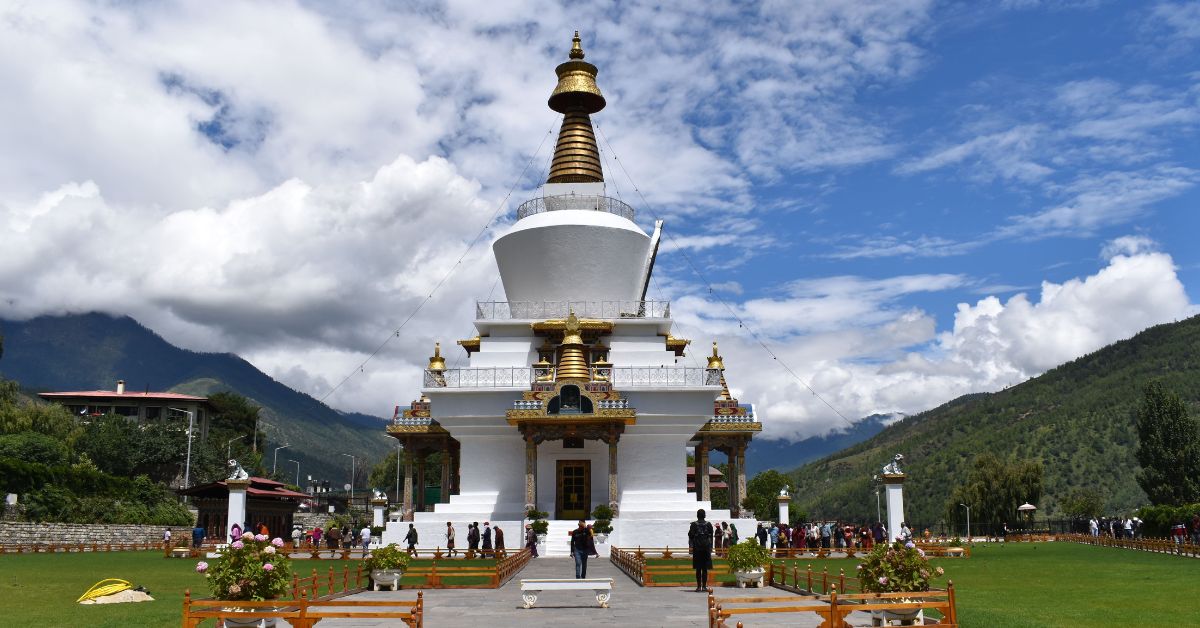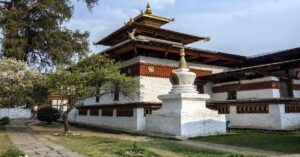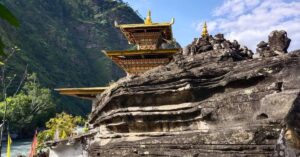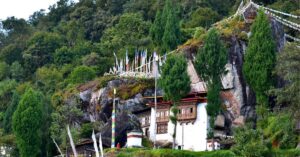The National Memorial Chorten, also known as Memorial Chorten or simply Thimphu Choeten, is a memorial stupa built by Queen Mother Ashi Phuntsho Choden Wangchuck in 1973. Gongzog Chorten was constructed in Thimphu, in memory of and to honor the third king of Bhutan, His Majesty Jigme Dorji Wangchuck, known as the Father of Modern Bhutan.
Thimphu Memorial Chorten is a Tibetan-style stupa, also known as the Jangchub Chorten, constructed in the form of a stupa-cum-temple, which is roughly similar to Jangtsa Dumtseg Lhakhang in Paro. While more of the traditional low stone towers, like the 108 chortens at Dochula Pass, are common in Bhutan, this type of chorten is also available.
How To Reach the National Memorial Chorten
The National Memorial Choeten is located on Doeboom Lam, near Jigme Dorji Wangchuck National Referral Hospital, above Royal Bhutan Police Headquarters. You can drive or walk to this place. Thimphu Chorten is open from 9:00 AM to 5:00 PM during the Summer and till 4:00 PM in winter. It is closed for lunch break from 1:00 PM to 2:00 PM. The entry fee for tourists is as follows: Nu. 500/- for general tourists, Nu. 250/- for students, and no entry fee for Children below the age of 5 years.
Sacred Relics to See at Memorial Chorten, Thimphu
- His Majesty Jigme Dorji Wangchuck’s Kupar;
- Three protective bodhisattvas – Avalokitesvara, Manjusri, and Vajrapani;
- Carvings of Ngawang Namgyal, Gautama Buddha, and Guru Padmasambhava;
- The Buddha statue;
- The paintings of various deities.
History of National Memorial Chorten
His Majesty Third Dharma King of Bhutan, Jigme Dorji Wangchuck, wished to “put into tangible form the three pillars of Buddhism.” To accomplish them, he sponsored the transcription of the Buddha’s speech, the Tenjur, in golden letters. He then completed 1,000 statues symbolizing the Buddha’s body. Unfortunately, His Majesty’s wish to build “a Choeten to represent the mind of the Buddha” was left unfulfilled when he passed away untimely.
Therefore, King’s mother, Ashi Phuentsho Choden Wangchuck, wanted to build a stupa to fulfill His Majesty’s wish and in his memory.
The Queen Mother requested Lam Sonam Zangpo to carry out the work. However, he was engaged in other work, so he tasked his son-in-law, Dungsey Thinley Norbu Rinpoche, to carry out the project. Rinpoche then conceived, designed, and built the stupa according to the treasure text of Dujom Lingpa. The outer was designed in the style of Jangchub Chorten, whereas the interior was the Vajrakilaya, Drukpa Lineage, and the Gongdue combined. The Stupa was consecrated by Dudjom Jigdrel Yeshe Dorji Rinpoche and named Gongzo Chorten, which translates to National Memorial Stupa.
Description of National Memorial Chorten
The Memorial Chorten of Thimphu was built in 1973. Today, the National Memorial Chorten has become one of the most iconic structures in Thimphu, where thousands of people visit every day to circumambulate the stupa and offer prayers.
The Chorten has four entrance gates, but only one of them is open to the public. It is decorated with three curved slats. The exterior of the gate has the three protective bodhisattvas – Avalokitesvara, Manjusri, and Vajrapani. On the interior are slats engraved with the image of Zhabdrung Ngawang Namgyal, Gautama Buddha, and Guru Padmasambhava. There are large prayer wheels always in motion to the left of the entry gate. There is also a small garden and green lawn in front of the stupa. Behind the stupa are a butter lamp house and a traditional building for conducting rituals.
National Memorial Chorten underwent extensive renovation in 2008.
Architecture
The architecture of Memorial Chorten is a Jangchub Chorten, one of the eight stupa types in Buddhism, with a distinctive vase-like design that flares outward rather than forming a dome.
Exterior
The chorten is a large white stupa with a golden spire atop it and another smaller one over the front porch. The chorten is embellished with intricately carved annexes facing all four directions.
Interior
Unlike other stupas in Bhutan, the memorial stupa has a temple built on all three floors and does not enshrine human remains. The ashes of His Majesty Jigme Dorji Wangchuck were interred at Kurjey Lhakhang in Bumthang. Only the Kupar of His Majesty Jigme Dorji Wangchuck in a ceremonial robe is enshrined in a hall on the ground floor. The ground floor is dedicated to Dorje Phurpa (Vajrakilya) teachings. It houses four shrines, each displaying portraits of four monarchs. The eastern shrine has a Buddha statue.
The second floor is dedicated to the teachings of the Drukpa Kagyu. It contains the Ka-Gye (Eight Great Sadhana Teachings), which were revealed by three Tertons: Nyang Ral Nima Oser, Guru Chowang, and Rigzin Godem, at different periods.
The top floor is dedicated to the teachings of Lama Gongdu, a terma revealed by Sangye Lingpa. It also features paintings depicting various deities of the Nyingma school, as well as visions that appear in the bardo.
There is a gallery above the top floor, which can be walked around, offering panoramic views of Thimphu city.
Religious Events at Memorial Chorten
The Vajra Kilaya Drupchen is held at the National Memorial Chorten. Many other religious events are also conducted by great Rinpoches and important lamas, where thousands of devotees gather to receive wang lung thri sum.
Best Time to Visit Thimphu Memorial Chorten
You can visit Thimphu Stupa at any season of the year. There is no best time to visit the Thimphu stupa. However, the best season to visit Thimphu Memorial Chorten is during the spring and autumn months, particularly in the early morning or late afternoon, to enjoy the monument’s serene ambiance and cultural vibrancy. You can visit the major pilgrimage sites of Thimphu with the Bhutan Pilgrimage Package.
Conclusion
National Memorial Chorten in Thimphu, Bhutan, is a Tibetan-style memorial stupa constructed in the form of a chorten-cum-temple. It was built in memory of and to honor the third king of Bhutan, His Majesty Jigme Dorji Wangchuck. The stupa was built by Queen Mother Ashi Phuntsho Choden in 1973. Dungsey Rinpoche conceived and designed the Thimphu Gongzo Choeten. Coinciding with the Coronation of the Fourth King, the stupa was consecrated by Dudjom Rimpoche in June of 1974.
Other Sacred Sites to Explore in Thimphu
Buddha Dordenma: It is a massive golden statue of Buddha Shakyamuni overlooking the Thimphu valley. The site also houses thousands of smaller Buddha statues and a meditation hall.
Tashichho Dzong: It is a fortress that houses the king’s throne room, government offices, and the central monastic body. Known as the “Fortress of the Glorious Religion,” it blends religious and administrative functions with stunning Bhutanese architecture.
Druk Wangyal Chortens: The Dochula Chortens are 108 memorial stupas on the Dochula Pass built by Ashi Dorji Wangmo Wangchuck in 2003. It was built to commemorate Bhutan’s victory led by His Majesty the Great Fourth and in honor of the soldiers who lost their lives in a military operation against insurgents in 2003.
Pangri Zampa Monastery: It is one of Bhutan’s oldest monasteries, founded in the 16th century by Ngawang Chogyal. The monastery now functions as Bhutan’s Royal College of Astrology, responsible for determining dates for important national events.
Cheri Monastery: It is the first monastery established in Bhutan by Zhabdrung Ngawang Namgyel in 1620.
Tango Monastery: The Tango Choying Dzong was founded in the 13th century by Phajo Drugom Zhigpo. The monastery is perched on a forested hillside near Cheri Mountain.
Enjoyed reading this blog?




